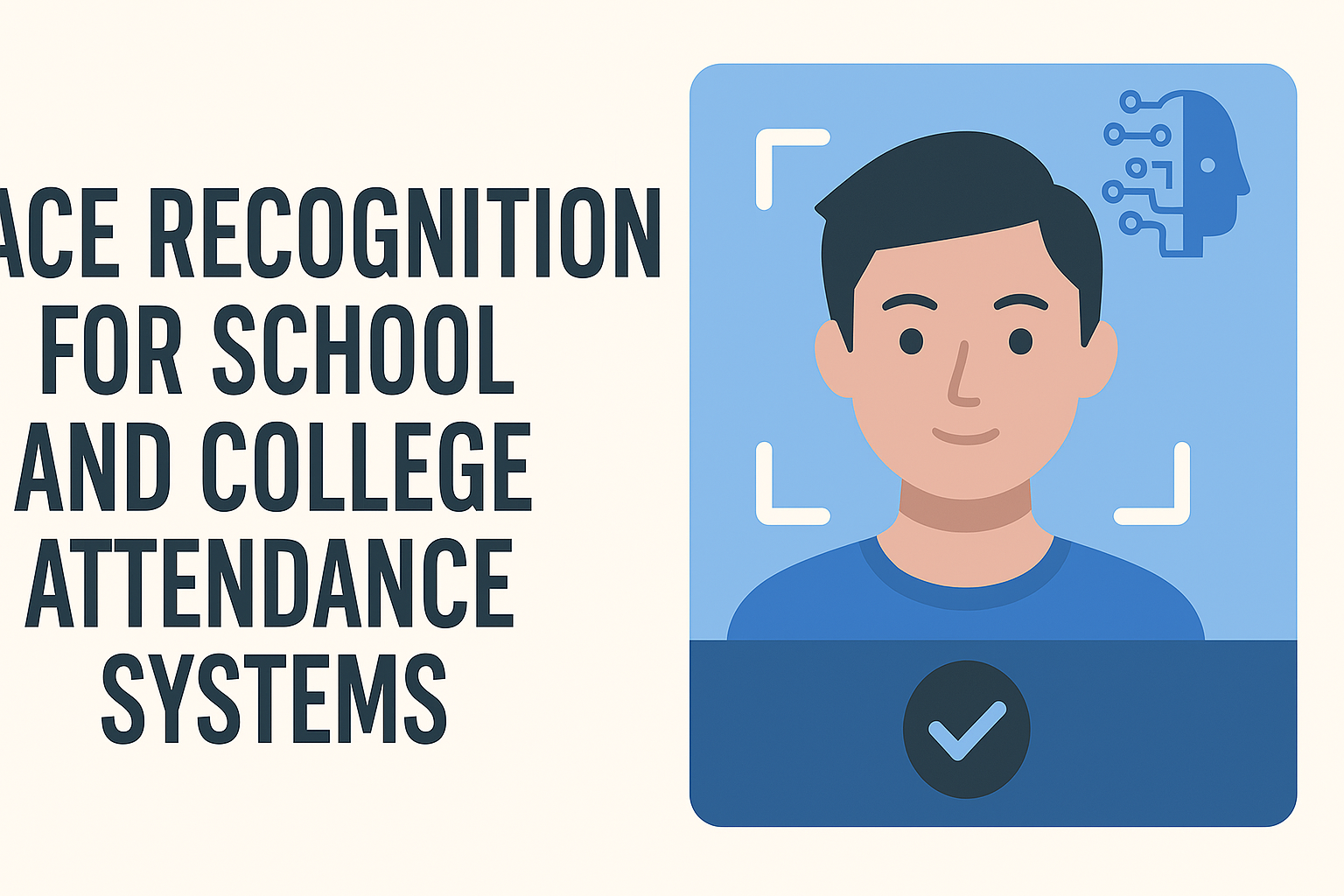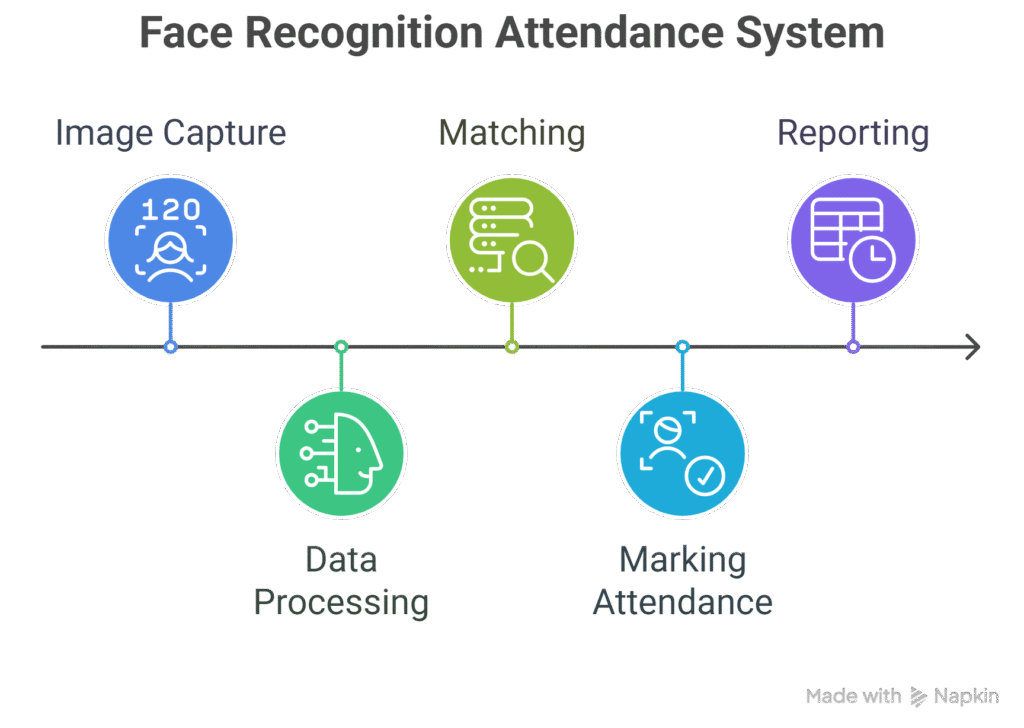
Table of contents
- What Are Face Recognition Attendance Systems?
- How Do Face Recognition Systems Work in Education?
- Key benefits for Educational Institutions
- Traditional Attendance vs. Face Recognition Attendance Systems
- Challenges and Considerations
- Real-World Examples and Success Stories
- Future Trends in Biometric Attendance Systems
- Conclusion
What Are Face Recognition Attendance Systems?
Face recognition attendance systems use advanced Artificial Intelligence to identify individuals by their facial features. Instead of passing a finger over a scanner or manually signing in, students and staff simply face a camera. The system compares their facial patterns with stored data and marks attendance automatically. This method offers faster and more reliable results than traditional methods.
By using face recognition for school and college attendance systems, educational institutions can create a secure, efficient, and error-free process. The technology eliminates human errors and reduces the time spent on manual attendance. It is well-suited for busy college campuses and large schools where speed is essential.
How Do Face Recognition Systems Work in Education?
Face recognition systems follow several simple steps:

- Image Capture: A high-resolution camera records the face of the student or staff member upon entry.
- Data Processing: The system uses AI algorithms to extract key facial features. It creates a digital template for that face.
- Matching: The system searches for a match within a pre-stored database of faces. This database is securely maintained by the institution.
- Marking Attendance: If a match is found, the system confirms the identity and marks attendance.
- Reporting: All attendance records are stored in a centralized system. Administrators can access real-time reports.
This entire process is fast and occurs in seconds. The combination of hardware and advanced software ensures that face recognition for school and college attendance systems operates seamlessly.
Key benefits for Educational Institutions
There are several reasons why schools and colleges are turning to face recognition. The benefits include:
- Time Efficiency: The system records attendance quickly. This saves time during classroom sessions and reduces the start-up delay.
- Accuracy: Automated identification minimizes errors. Unlike manual systems, no attendance is missed or recorded incorrectly.
- Enhanced Security: Only registered individuals can gain access. This helps prevent unauthorized entries and increases campus security.
- Cost Savings: While the initial investment may be higher, the long-term savings in labor and administrative costs are significant.
- Data Insights: Educational institutions can generate detailed reports. These insights can help in understanding attendance patterns and improving resource allocation.
- User-Friendly Experience: The process is simple and non-intrusive. Students merely need to look at the camera to have their attendance recorded.
Traditional Attendance vs. Face Recognition Attendance Systems
Below is a table that compares traditional attendance methods with face recognition systems:
| Feature | Traditional Attendance | Face Recognition Attendance Systems |
|---|---|---|
| Data Collection | Manual entry or swipe cards | Automated facial recognition |
| Time Efficiency | Time-consuming and prone to delays | Instantaneous processing, saving valuable time |
| Accuracy | Errors due to manual input | High accuracy due to AI-driven algorithms |
| User Experience | Cumbersome and often disruptive | Seamless and non-intrusive |
| Security | Vulnerable to proxy attendance or fake entries | Enhanced security with biometric verification |
| Maintenance | Requires regular manual checks | Low maintenance with automated updates |
| Cost Over Time | High operational and labor costs | Lower operational costs after initial investment |
Challenges and Considerations
Despite its many benefits, face recognition systems come with some challenges that institutions must consider:
- Privacy Concerns: Collecting and storing biometric data may raise privacy issues. Schools must ensure that data is protected with robust security measures. Transparent policies and compliance with local regulations are essential.
- Initial Cost: The technology can be expensive to install. However, the long-term savings often outweigh the initial capital expenditure.
- Technical Issues: In areas with poor lighting or high traffic, accuracy may be affected. Regular maintenance and software updates can help alleviate these issues.
- Data Security: Protecting sensitive biometric data is critical. Institutions should invest in secure servers and encryption technologies to guard against data breaches.
- User Adaptability: Some students or staff may resist adopting new technology. Proper training and clear communication can ease the transition.
Addressing these challenges properly is key to maximizing the benefits of face recognition for school and college attendance systems.
Real-World Examples and Success Stories
Many educational institutions around the globe have adopted face recognition technology successfully. For example:
- A top university in Asia introduced face recognition for attendance. This move reduced class start delays by 70% and improved overall security.
- Several schools in Europe reported a 50% reduction in proxy attendance when they switched to facial recognition systems.
- In North America, colleges that adopted the system experienced higher student satisfaction due to the speed and simplicity of the process.
These real-world examples create a strong case for the adoption of face recognition in educational settings.
Future Trends in Biometric Attendance Systems
The future of facial recognition in education looks promising. Emerging trends include:
- Enhanced AI Algorithms: Continuous improvements in AI will increase accuracy even further. Future systems will be more adaptive to diverse environments.
- Integration with Other Systems: Face recognition can combine with other technologies (e.g., smart scheduling and campus safety systems). This integration will offer holistic campus management solutions.
- Mobile Integration: Future systems may allow students to record attendance via their mobile devices with advanced facial recognition apps. This will further simplify the process.
- Increased Adoption: As costs decrease and technology matures, more schools and colleges will adopt these systems, setting a new standard for attendance.
- Better Privacy Measures: Future developments will ensure robust privacy protection. Advanced encryption and secure data management will become standard features.
These trends indicate that face recognition for school and college attendance systems is set to become even more efficient, secure, and widely adopted in the near future.
Conclusion
All over the world, forensic facial recognition for attendance systems for schools and colleges represents a new approach to the education world. The biometric technology represent an efficiency, accuracy and security of the attendance process that could not be achieved in the past. Now attendance taking has been simple and automated process that could save time and errors in an efficient way.
Educational institutions can now ditch temperature crazed attendance systems so that our educators can concentrate on learning and teaching.